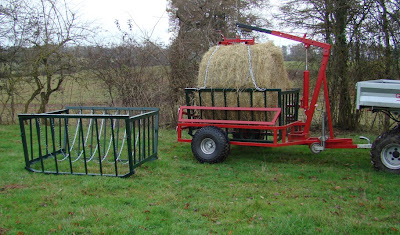Wednesday, 26 January 2011
Lambing Time
So once again the busiest time of the year has come around. Lambing always seems to catch us not quite ready and prepared, no matter how hard we try. Every year is different, and this year has seen a few more single lambs than normal, probably because of the dry summer, but lots of healthy lambs and relatively few problems with the ewes. Sometimes we have to assist the ewes with their lambing, turning lambs around, untangling them and making sure the presentation is correct. The Vendeen ewes are quite easy to lamb because the lambs are unusually soft and flexible, and the head is not too blunt in shape.
.
Straight after lambing we pen the mothers and their lambs seperately for a day or two to make sure everything is normal. After lambing the ewes are working their hardest, producing milk and looking after the lambs. Our sheep normally have two lambs, sometimes one and occasionally three - we even had a quadruplet birth this year.
We only keep two lambs on the ewes themselves, so these multiple births mean that we have a bunch of baby lambs to rear by hand every year. With up to sometimes over forty lambs arriving on the same day, this is an extra burden at a very busy time. We try to keep the lambing compact, so that it is spread over as short a time as possible. That way the lack of sleep is not quite so punishing.
Once they have lambed, the mothers and their lambs stay inside for about a week and if the weather is not too bad we put them outside and continue to feed them hay and concentrate feed there.
Tuesday, 21 December 2010
Recently I have been very busy improving our hay delivery system for the sheep when they are outside in the fields.We wanted to be able to keep the sheep outside for the majority of the winter but at the same time make sure our fields were not damaged. Normally a tractor would carry the bales of hay to the sheep, but the fields become very soft in the winter and a tractor would leave ruts and ruin the soil structure. To avoid this, we have upgraded to a more powerful quad to help. This one has what is called hydrostatic drive - four seperate hydraulic motors, one on each wheel, which means it does not need to have brakes or a gearbox or the normal transmission equipment.
I have also made four hay racks and a special trailer to carry the hay out to the field already inside a hay rack. The crane on the front of the trailer can pick up a hay rack full of hay and we can then transport it securely wherever we want it behind the quad without damaging the fields, even when it has been raining.
Friday, 3 December 2010
Winter is really here
 | |||
| Wyn and Belle |
 |
| Winter Feeding |
Wednesday, 1 December 2010
First post
The Aims of this Blog
This blog has been set up for the benefit of my two young cousins - Alex and Julian. I aim to post a diary of events that happen during the farming year on our sheep farm.
 |
| Aerial photo of Rouyère |
A Profile of the Farm
Our farm, Rouyère, is a 44 hectare (100 acre) all grass farm in the Vienne department of central west France about 200 metres above sea level. We keep 425 ewes and 18 rams. We lamb about 280 in January/February and 70 in March/April. The remaining 75 are the replacement flock who will not lamb in their first year. The breed we keep is the Vendéen - a hardy breed, capable of utilising grass well and of very good conformation. We do not grow any cereal crops but we do reseed our grass fields regularly.
The soil is a relatively stone-free sandy silt over a crumbly granite bedrock. In places the soil is deep although generally no more than average depth. Being almost stone free, it is very sensitive to damage from heavy vehicles when wet, so we use low-ground pressure vehicles - quads/atvs for a lot of the daily chores. In winter, because of the impervious nature of the bedrock, the soil can remain waterlogged for weeks on end, and most of the 850mm annual rainfall occurs between October and March. We get, on average, about 2,400 hours of sunshine per year. In summer, due to the strong sun and prolonged dry periods, the grass growth can come to a virtual halt, sometimes for two or three months. Spring however, if the rain is plentiful, produces grass in abundance, and hay is made from about a quarter to a third of the farm.
Subscribe to:
Comments (Atom)










